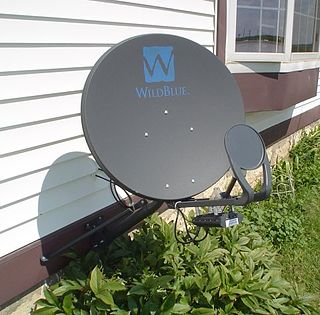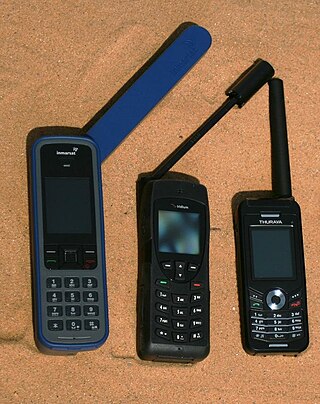
General Packet Radio Service (GPRS), also called 2.5G, is a packet orientated mobile data standard on the 2G cellular communication network's global system for mobile communications (GSM). GPRS was established by European Telecommunications Standards Institute (ETSI) in response to the earlier CDPD and i-mode packet-switched cellular technologies. It is now maintained by the 3rd Generation Partnership Project (3GPP).

Integrated Services Digital Network (ISDN) is a set of communication standards for simultaneous digital transmission of voice, video, data, and other network services over the digitalised circuits of the public switched telephone network. Work on the standard began in 1980 at Bell Labs and was formally standardized in 1988 in the CCITT "Red Book". By the time the standard was released, newer networking systems with much greater speeds were available, and ISDN saw relatively little uptake in the wider market. One estimate suggests ISDN use peaked at a worldwide total of 25 million subscribers at a time when 1.3 billion analog lines were in use. ISDN has largely been replaced with digital subscriber line (DSL) systems of much higher performance.
Iridium Communications Inc. is a publicly traded American company headquartered in McLean, Virginia, United States. Iridium operates the Iridium satellite constellation, a system of 75 satellites: 66 are active satellites and the remaining nine function as in-orbit spares. Iridium Satellites are used for worldwide voice and data communication from handheld satellite phones, satellite messenger communication devices and integrated transceivers, as well as for two-way satellite messaging service from supported conventional mobile phones. The nearly polar orbit and communication between satellites via inter-satellite links provide global service availability.

Dial-up Internet access is a form of Internet access that uses the facilities of the public switched telephone network (PSTN) to establish a connection to an Internet service provider (ISP) by dialing a telephone number on a conventional telephone line. Dial-up connections use modems to decode audio signals into data to send to a router or computer, and to encode signals from the latter two devices to send to another modem at the ISP.

In telecommunications, broadband or high speed is the wide-bandwidth data transmission that exploits signals at a wide spread of frequencies or several different simultaneous frequencies, and is used in fast Internet access. The transmission medium can be coaxial cable, optical fiber, wireless Internet (radio), twisted pair cable, or satellite.

Internet access is a facility or service that provides connectivity for a computer, a computer network, or other network device to the Internet, and for individuals or organizations to access or use applications such as email and the World Wide Web. Internet access is offered for sale by an international hierarchy of Internet service providers (ISPs) using various networking technologies. At the retail level, many organizations, including municipal entities, also provide cost-free access to the general public.

A satellite telephone, satellite phone or satphone is a type of mobile phone that connects to other phones or the telephone network by radio link through satellites orbiting the Earth instead of terrestrial cell sites, as cellphones do. Therefore, they can work in most geographic locations on the Earth's surface, as long as open sky and the line-of-sight between the phone and the satellite are provided. Depending on the architecture of a particular system, coverage may include the entire Earth or only specific regions. Satellite phones provide similar functionality to terrestrial mobile telephones; voice calling, text messaging, and low-bandwidth Internet access are supported through most systems. The advantage of a satellite phone is that it can be used in such regions where local terrestrial communication infrastructures, such as landline and cellular networks, are not available.

Satellite Internet access is Internet access provided through communication satellites; if it can sustain high speeds, it is termed satellite broadband. Modern consumer grade satellite Internet service is typically provided to individual users through geostationary satellites that can offer relatively high data speeds, with newer satellites using the Ku band to achieve downstream data speeds up to 506 Mbit/s. In addition, new satellite internet constellations are being developed in low-earth orbit to enable low-latency internet access from space.
The BT Versatility is a telephone PBX switchboard sold by BT and targeted at small businesses. It is manufactured by Taratel Communications previously Lake Communications in Ireland as the OfficeLink. In South Africa it was sold by Tellumat as the Convergence 30 or C30, in Australia it was sold as the Commander Connect, in the USA it was sold by Inter-tel as the Encore CX and by Mitel as the Mitel 3000

Inmarsat is a British satellite telecommunications company, offering global mobile services. It provides telephone and data services to users worldwide, via portable or mobile terminals which communicate with ground stations through fifteen geostationary telecommunications satellites.
SITAONAIR is a company that enables airline passengers to use their smart devices including mobile phones and laptops for calls, text messaging, emails and Internet browsing.
Audio over IP (AoIP) is the distribution of digital audio across an IP network such as the Internet. It is used increasingly to provide high-quality audio feeds over long distances. The application is also known as audio contribution over IP (ACIP) in reference to the programming contributions made by field reporters and remote events. Audio quality and latency are key issues for contribution links. In the past, these links have made use of ISDN services but these have become increasingly difficult or expensive to obtain.
SES Broadband is a two-way satellite broadband Internet service available across Europe, which launched in March 2007, and uses the Astra series of geostationary satellites.
BT Highway was a UK retail ISDN2e service from British Telecom which was announced in November 1997 and withdrawn in February 2007. In the domestic market, it was sold as BT Home Highway and for small businesses, BT Business Highway. These names were used simply to differentiate billing schemes; the hardware for both services used the name BT Highway. Unlike regular ISDN2e service where only a digital S interface is provided BT Highway provided both digital and analogue connections simplifying migration from regular POTS service.
FleetBroadband is maritime satellite internet, telephony, SMS texting, and ISDN network for ocean-going vessels using portable domed terminal antennas.
The I-4 satellites are made up of the INMARSAT BGAN, FleetBroadband and SwiftBroadband communications network. They provide Internet and telecom connections on the L band everywhere on Earth, except in polar regions.

SES Broadband for Maritime is a two-way satellite broadband Internet service for use on private boats and commercial ships throughout European waters.

A mobile broadband modem, also known as wireless modem or cellular modem, is a type of modem that allows a personal computer or a router to receive wireless Internet access via a mobile broadband connection instead of using telephone or cable television lines. A mobile Internet user can connect using a wireless modem to a wireless Internet Service Provider (ISP) to get Internet access.
SwiftBroadband is an IP-based packet-switched communications network that provides a symmetric ‘always-on’ data connection of up to 650 kbit/s per channel for aircraft globally except for the polar regions, using the Inmarsat satellite constellation.

Mobile-satellite service is – according to Article 1.25 of the International Telecommunication Union's Radio Regulations – "A radiocommunication service











